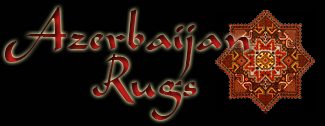|
SOME NOTES ON THE SO CALLED 'OYSUZLU' DESIGN
What is Oysuzlu?
Öysüzlü (Oysuzlu) is the name of two
villages (Ashaghy Öysüzlü, Yukhary Öysüzlü) located in Tovuz district of the
historical Kazak (Qazakh) Region of Azerbaijan. These two and neighboring
villages are inhabited by Ayrim, Kazak and Shamshaddin tribes of Azeri Turks.
The names of these villages are in Azeri Turkic language.
Etymology: Öysüz or Öksüz means a “nomad” in all Oghuz dialects, including
Azeri. The closest equivalent of “Ö” in English would be a rounded version of
the "u" in "burn" for the long Ö sound and the short Ö sound like "u" in "fur".
|
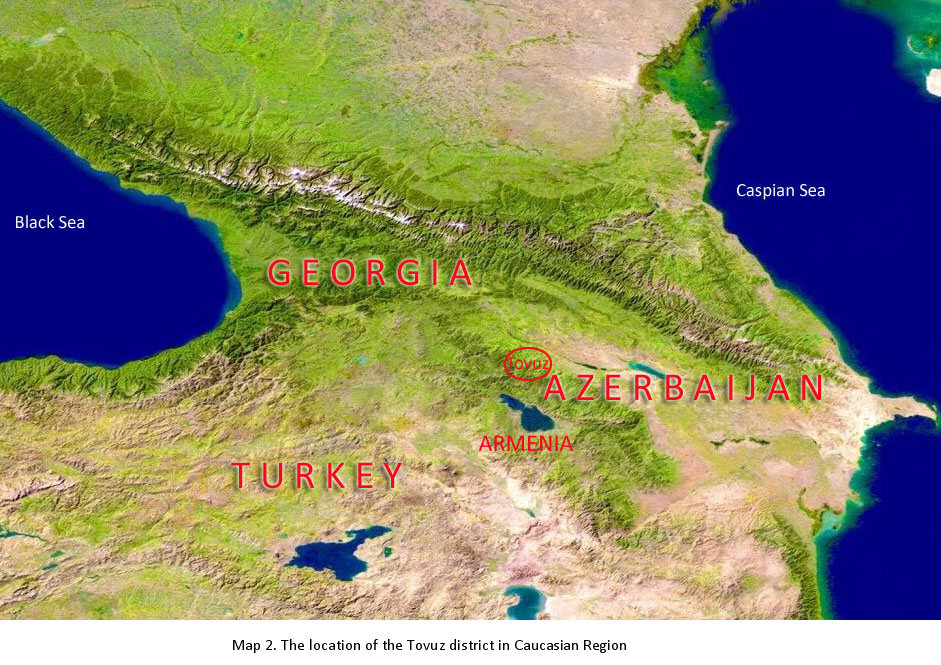
Map 2. The location of the Tovuz
district in Caucasian Region |
Latif Kerimov* claims
that these two villages (Map 1) are responsible for the
weaving of so called Öysüzlü rugs.
*The development of ornamental and
pictorial carpets in modern Azerbaijan is closely connected with the name
of the great carpet designer and national artist Latif Husein Kerimov
(1906-1991) . Scientific chronicler, historian of Azerbaijani carpet art, carpet
designer and artist, Kerimov was also a connoisseur of Azerbaijani and Eastern
literature and a virtuoso of the naskh and nastaliq styles. Using his profound
knowledge of traditional ornamental art, he created new decorative motifs.
Kerimov founded the State Museum of Azerbaijani Carpet and Applied Arts, which
opened in Baku in 1967. He was also involved in organizing two international
UNESCO-sponsored symposiums, “Oriental Carpet Art” and “Azerbaijani Carpet Art”,
held respectively in 1983 and 1988 in Baku. Kerimov’s unique works were
exhibited in many countries. He carried out extensive research in the field of
applied decorative arts. His creations and his erudition both contributed to the
diffusion of Azerbaijani culture, and he was one of the most celebrated
intellectuals in the East.
Perhaps these two and other surrounding villages in Tovuz
District wove this type of rugs, but the main weaving
area of this design should be Borchaly (Bordjalou) Region.
In the map 3, the red and green areas show the location of the historical Kazak and Borchaly Regions.
A SHORT HISTORY NOTES
|
The first Turkic tribes who appeared in
the region were some of the Scythians tribes (Ancient people of
horse-riding nomadic pastoralists who appeared in Transcaucasia in the
7th century BC), Bunturks (early Turkic people appeared in
Transcaucasia 4th century BC), Huns (a group of Turkic nomadic
pastoral people who, appearing from beyond the Volga, migrated into
Europe c. 370 AD), Bulgars (Turkic people that migrated to Europe from
Central Asia in the 4th century), Barsils (a semi nomadic Turkic
tribe), Khazars (semi-nomadic Turkic people who dominated the Pontic
steppe and the North Caucasus from the 7th to the 10th century),
Kypchaks (also known as Poloves, Cumans or Kuns) and later Oghuz Turks
(from the 10th century).
The present day Turkic
population of Kazak and Borchali regions can be considered as the
descendant of the above mentioned tribes - mainly Kypchak and Oghuz. |
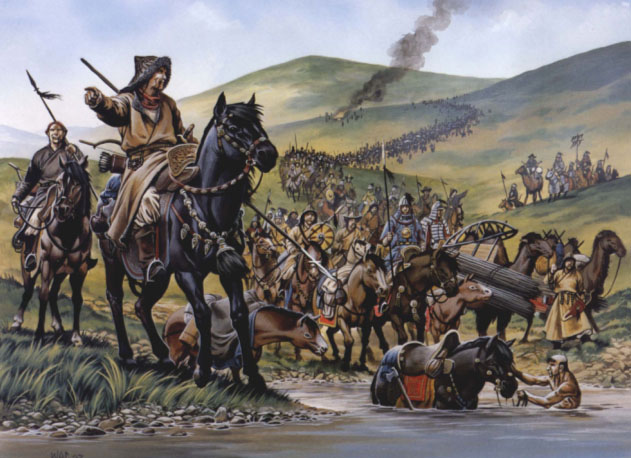 |
THE TRIBES OF KAZAK REGION TODAY: Ayrims, Shamshaddins and Kazaks
It is worthwhile to mention shortly about the history of these tribes, who were
the weavers of many antique Kazak rugs (Kazak, Akstafa, Tovuz, Shamshaddin,
Gedebey and Göyche(Sewan)) districts).
|
Ayrim: It is believed that Ayrims
came to the region within 30 000 Turkmens, who were forced to move
from Anatolia to Azerbaijan by Tamerlane, when he defeated Sultan
Beyazid in Ankara Battle (1402). It is unknown, to which Oghuz Tribe
Ayrims belonged to. |
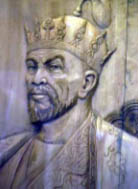
Timur (April 8, 1336 – January 19,
1405), normally known as Tamerlane in English, was a 14th-century
conqueror of much of western and central Asia, founder of the Timurid
Empire and Timurid dynasty (1370–1405) in Central Asia |
Shamshaddin or Shamshaddil:
Shamshaddin was a subtribe of Dhulkadirli Tribe. Dhulkadirli (Dhu
‘l-Kadirli) was the name of a large ulus of tribesmen (mainly Bayat,
Afshar and Beydili tribes of Oghuz), widely spread not only in E.
Anatolia but also in Safawid domains, where they formed an influential
element in the state. Shamshaddin tribe took their name probably from
a tribal leader whose name was Shamsaddin.
In the first quarter of the 16th century, Shah Ismail I Safavi
(1501-1524) assigned Tovuz and neighboring districts to Shamsaddin
tribe. The region was within the boundaries of Karabagh Beylerbeyi (a
province of the Safavid Empire). |
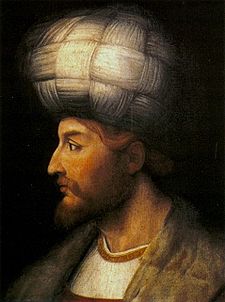
Shah Ismaill Safavi (July 17, 1487 – May
23, 1524) was the founder of the Safavid Empire |
Kazakh or Qazakh: They are considered as a subtribe of Kypchak. The
subgroups of Kazakh are Salahli, Kesemen, Poylu, Demirchiler etc.
THE ORIGIN OF THE DESIGN
The motifs of this type of rugs have pre-Islamic Turkic totemic sources. Many
geometric devices used in Oysuzlu type of rugs can be found commonly in rugs of
Turkic speaking people of Central Asia: Turkmen, Kyrghyz, Kazak and Karakalpak.
TYPES
TYPE A
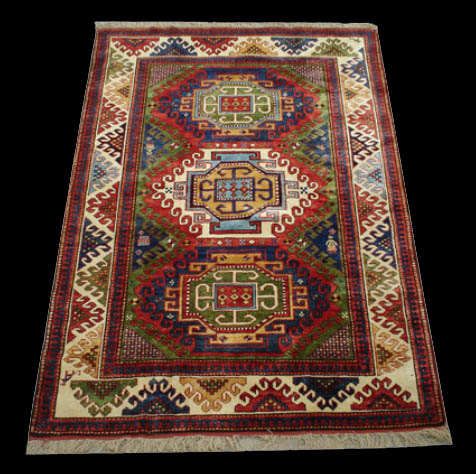
Although the design is attributed
to Oysuzlu by L. Kerimov, it is almost certainly known that the rugs with this
specific design were produced in the villages of Lowland Bordjalou Region, not
in Oysuzlu village of Tovuz District (Kazak Region).
The main feature of this design is having two interlocked grounds in the central
field: the green and red areas in this example (background vs. foreground). The
composition of the central field consists of the three hooked medallions and
half hook-rimmed lozenges on the sides of the central field aligned on the
vertical axis.
The cruciform device inside the ketebe of the central medallion is often found
in Kazak, Ganja, Bordjalou and even in some Kuba rugs in different forms. The
device basically consists of a cross with the four ends of which terminate in a
pair of horns.
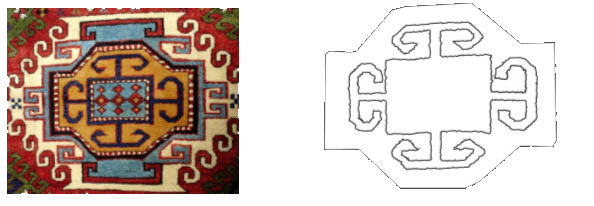
Here are the same type of hooked
devices in various shapes used in so called “Sewan” rugs.
What does this motif represent
for? It could well be representing a tamga – a mark used mainly by Turkic people
representing an emblem of a particular tribe or a clan. They used tamgas to
identify property or cattle belonging to a specific Turkic clan, usually as a
stamp. Some tribes, like the Ak Koyunlu (White Sheep), put their tamga on their
flags and stamped their coinage with it.
|
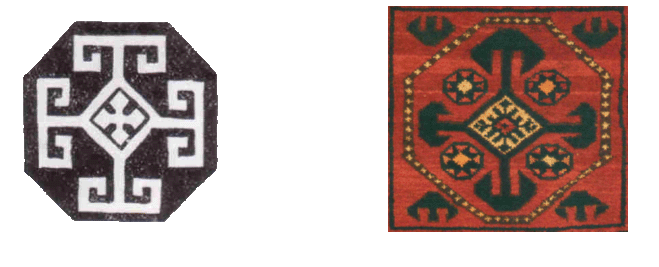
The Karakalpak
Kochot Pattern |
A considerable number of Kyrgyz and Kazak rugs contain a motif frequently
described as Karakalpak kochot. The similarity of the Karakalpak kochot and
Borchaly/Oysuzlu device is clear. Karakalpak kochot also consists of a cross,
the four ends of which terminate in a pair of horns. A very similar motif occurs
in the embroidery of the Karakalpaks of the Aral delta (especially on the top of
skull caps). In fact, this motif can be found in the applied art works of all
Turkic People, from Central Asia to Iran, from Caucasia to Anatolia:
Koch or Kosh (qošqar) means a ram in all Turkic languages. As the name of this
motif in Kyrgyz and Karakalpak is related to a ram, this suggests us the motif
could be representing ram’s horn.
The hooked gül /inner medallion
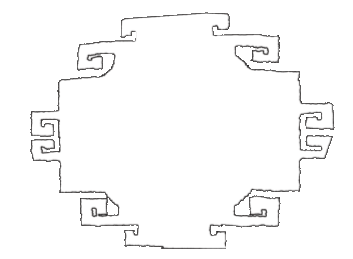 which
is containing the ketebe which
is containing the ketebe 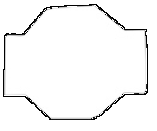 and
the cruciform device and
the cruciform device 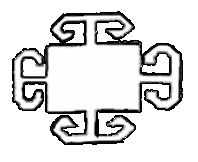 can be
related to the early Central Asian forms and a number of Turkish rugs from
Anatolia. can be
related to the early Central Asian forms and a number of Turkish rugs from
Anatolia.
The hooked medallion
 can
also be considered as a stylized Mughan or so called Memling gul. can
also be considered as a stylized Mughan or so called Memling gul.
|
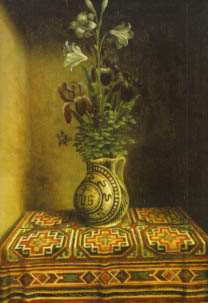
Depiction of a ‘Memling Gul’ rug in a still-life with a flower vase by Hans
Memling, before 1494
|
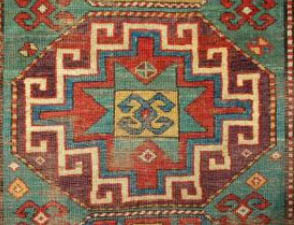
A 19th century Kazak rug with Mughan (Memling) Gul motif
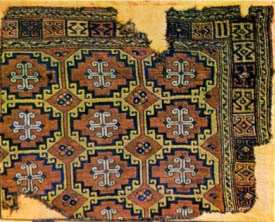
A 14th -15th century Turkish rug with Mughan gul motif

18th century Konya rug with stylized Memling Guls
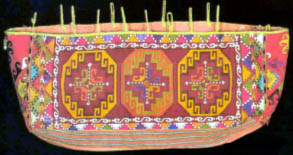
A Lakai Uzbek mapramach with a Memling gul pattern

A Karkalpak qarshın with a Memling Gul motif
THE BORDER
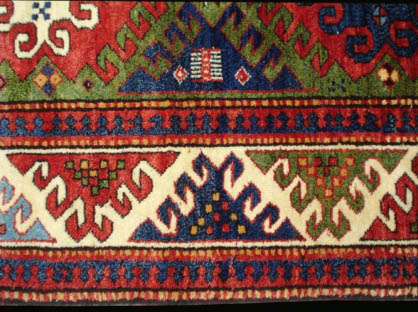
The main border on an ivory ground consists of half hook-rimmed lozenges
arranged opposite one another and staggered. The similar motifs are found in
Anatolian and other Caucasian weavings a lot. In Turkey, the motif is often
referred as scorpion or tarantula. The below picture shows different type of hooked elements
used in Anatolian and Caucasian weavings (pile rugs, kilims, mafrashes etc.)
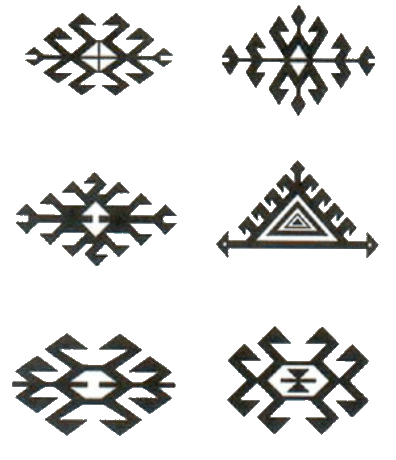
Similar elements can be found in
the applied art of all Turkic People - the most prolific weavers in Central Asia, Anatolia and Caucasia.
The similar hooked element which
is called "Koch Buynuzu" in Anatolia, Kochkar in Turkmenistan, Qoch Buynuzu in
Azerbaijan, Kochkor in Uzbekistan, Koshkar Muiz in Kyrgyzstan and Kazakstan, symbolizing the power or fertility is perhaps
the most abundantly used element between all Turkic people. The similar shapes
can be found in the weavings of other ethnic groups such as Kurds and Luris too.
TYPE B
The following two pieces are also
attributed to Oysuzlu by Kerimov. Although the hooked zig-zag border is
generally considered as one of the most common features of antique Bordjalou
rugs, the connection of this pattern to Tovuz Oysuzlu rugs needs a further
investigation.
TYPE C
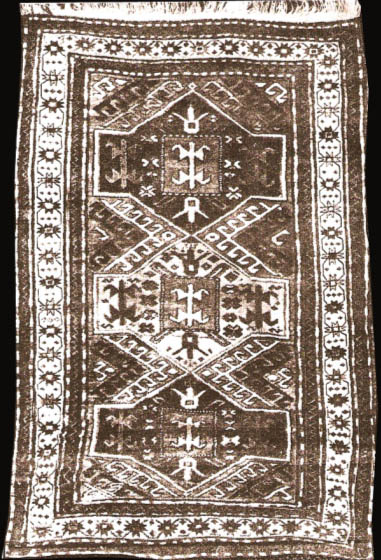
The third rug which is also attributed to Oysuzlu by Kerimov carries strong
features of the NW Karabagh (Kelbajar-Chilebord (Chelaberd) District) rugs.
Structure analysis of Borchaly and Oysuzlu
(Tovuz) rugs:
Borchaly rugs with hooked
medallions and half hook-rimmed lozenges:
Warp: always wool, Z 3 S, beige or brown
Weft: always wool, Z 2, light red or dark red, 3-5 shots
Pile: wool, Z 2
Pile height: 8-10 mm
Knots: Symmetrical (Turkish), 70 000 – 90 000 knots per square meter
Selvedge: in most cases, 2 cords of wefts wrapped around warps, sometimes
wrapped with supplemental threads
Oysuzlu (Tovuz) rugs:
Warp: always wool, Z 3 S, beige or brown
Weft: always wool, Z 2, light red, dark brown or dark red, 4-5 shots
Pile: wool, Z 2
Pile height: 10-11 mm
Knots: Symmetrical (Turkish), 60 000 – 80 000 knots per square meter
Selvedge: 2-3 cords of wefts wrapped around warps
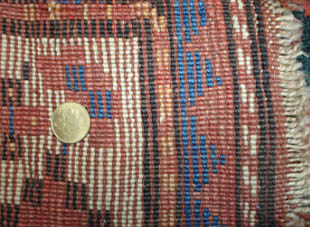
The backside of an antique
Tovuz rug
|
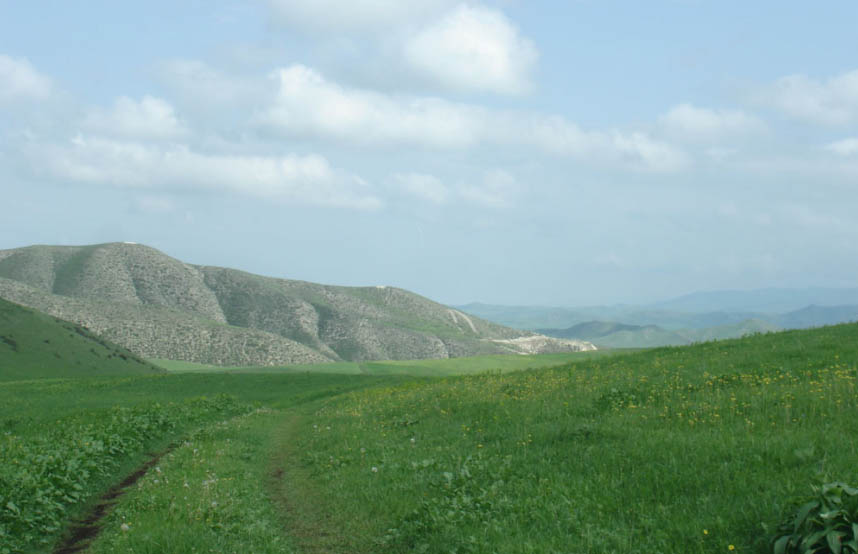
Ağdağ near
Öysüzlü village |
|
